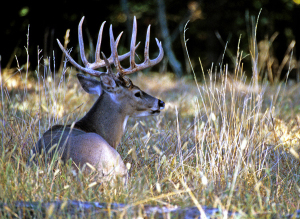By Chris Erwin
Is your deer gun whispering to you as you walk past the gun cabinet? If you get that feeling, you need to be out in the woods. Now isa good time to start scouting for that deer you plan to take during modern gun season.
If this is your first year at hunting deer, we have a few suggestions and tips that can improve your chances. There was a time in Kentucky that harvesting a deer was a long shot at best. The good news is that time passed a long time ago, and your chances are very good in almost every county in Kentucky.
In the last 30 years, I have harvested deer using a bow, a hand gun, a muzzle loader, shotgun and slug barrel, and a modern rifle. The only means of taking a deer I haven’t used is a crossbow, and I have been thinking about doing that next year.
This time of year, and for the record this is late September, deer are still in the late-summer pattern. This will all change as deer begin to approach the rut. However, this is the time to begin working on your strategy if you want to bag a trophy.
When I go into the woods scouting for the first time in late summer, I take a few things with me. I take a cloth tape measure because it makes less noise, a pair of surgical gloves, which I use to examine droppings, a good pair of field glasses, and a topography map to mark my findings. These tools will help me understand the terrain and how the deer is using the property.
I use these tools to try to establish a few things. How many deer are using the area? Where are they feeding? Where are they bedding? Where are they staging? What are their migration routes from one to the other? I’m measuring droppings, tracks and beds to get an idea about the size of the deer and to establish how the doe family is using the property, as well as if any bucks are in the area and how they relate to the doe family.
Now this will change as we get into the rut. However, knowing how the deer are using the property will give you an advantage once it’s time to start building or setting a blind.

It’s a good idea to do your scouting at mid-day when the deer are bedding but don’t go into bedding areas, you don’t want to jump the deer. During this time of the day, I’m looking for feeding areas and glassing field edges looking for places where the deer are moving in and out of the fields. Finding dropping in feeding areas will also give me a good idea what they are feeding on and the size of the deer.
In the warm months deer like to be near water, food and bedding areas. They don’t move great distances as a rule unless they feel threatened. Your scouting must be done leaving little trace that you have been there. Don’t take a leak, drop cigarette butts or discard food wrappers. You want to do your scouting in stealth mode, gathering your information without leaving any sign you have been there.
In the morning or evening when I know the deer are moving I want to be in a place where I can see the bedding areas. I want to get a look at the deer moving out of the bedding areas and into the feeding areas. Usually, you can watch the fields as they get up and make their way into the woods. You want to make sure you are not down wind and that you’re high enough to watch them without making a lot of movements. As they move into the woods, they will stage in groups just in the edge of the woods. These are prime bow hunting sites.
Once you are home lay out your map. Mark where the bedding areas are, where the feeding areas are, where the staging areas are, where the water is and mark the direction of the wind (morning and evening).
You have just completed the first stage of learning your prey. Next week, we will cover how you use this information as we approach the rut, what is likely to change, what scrap lines are and building blinds.


Be the first to comment